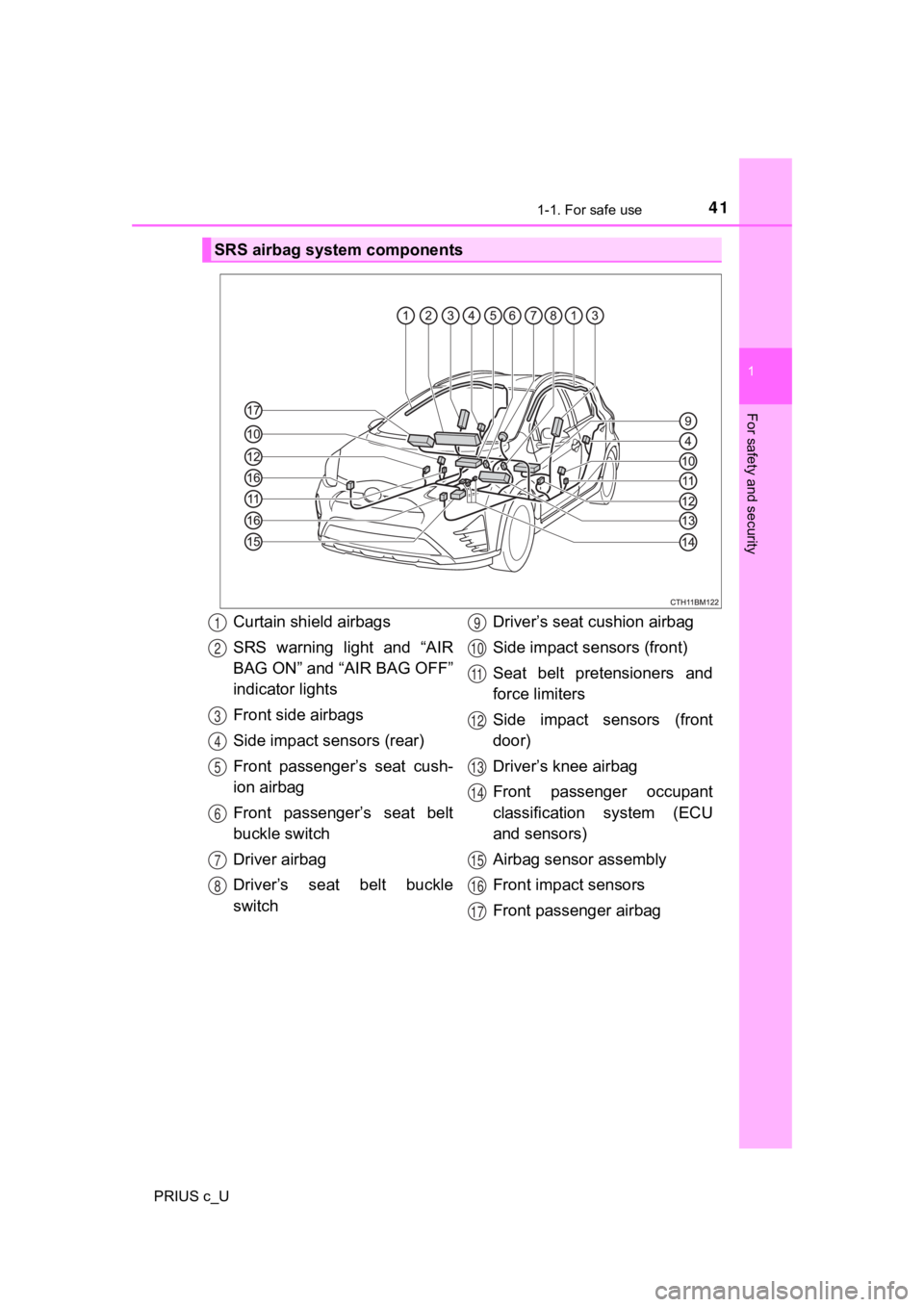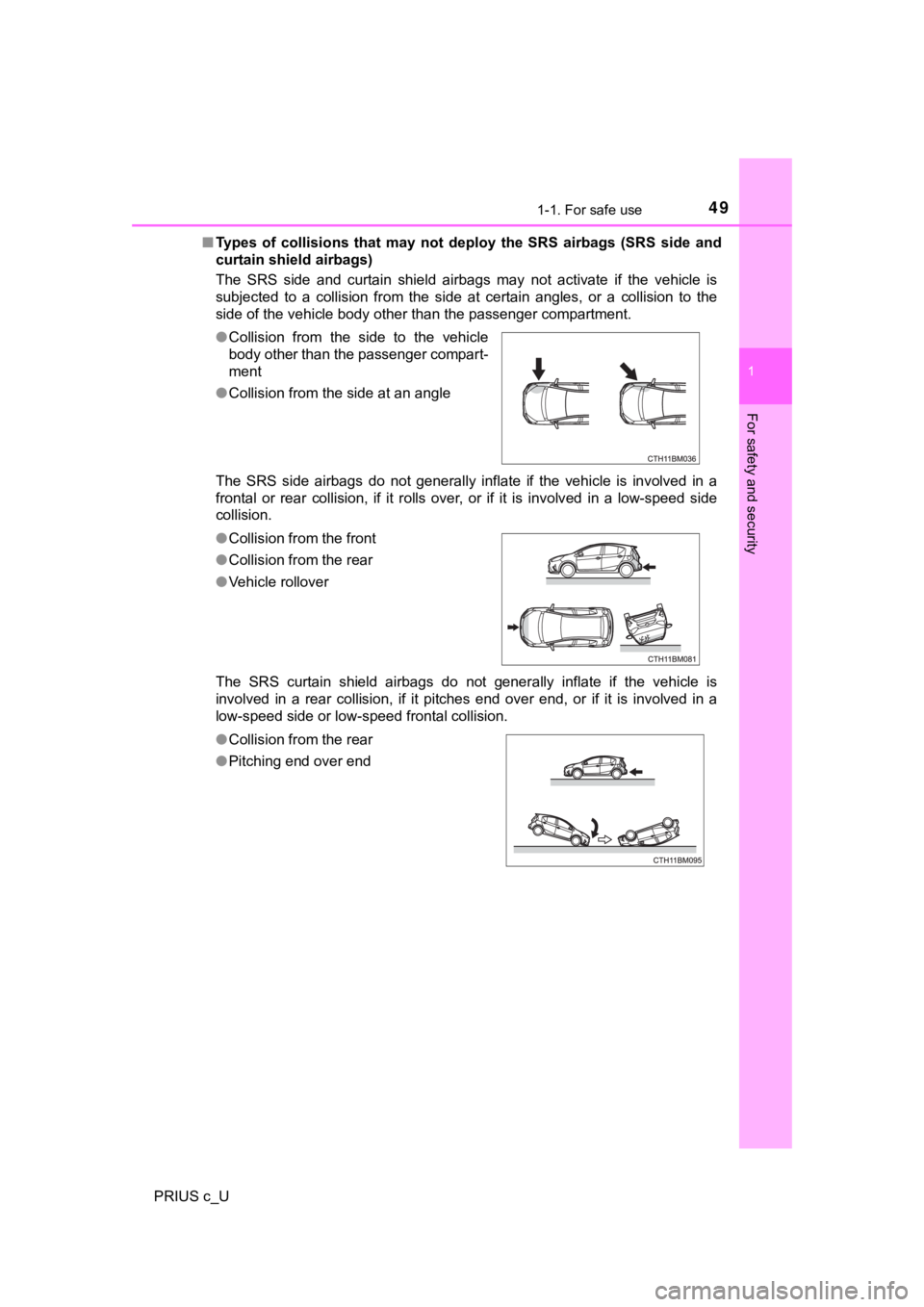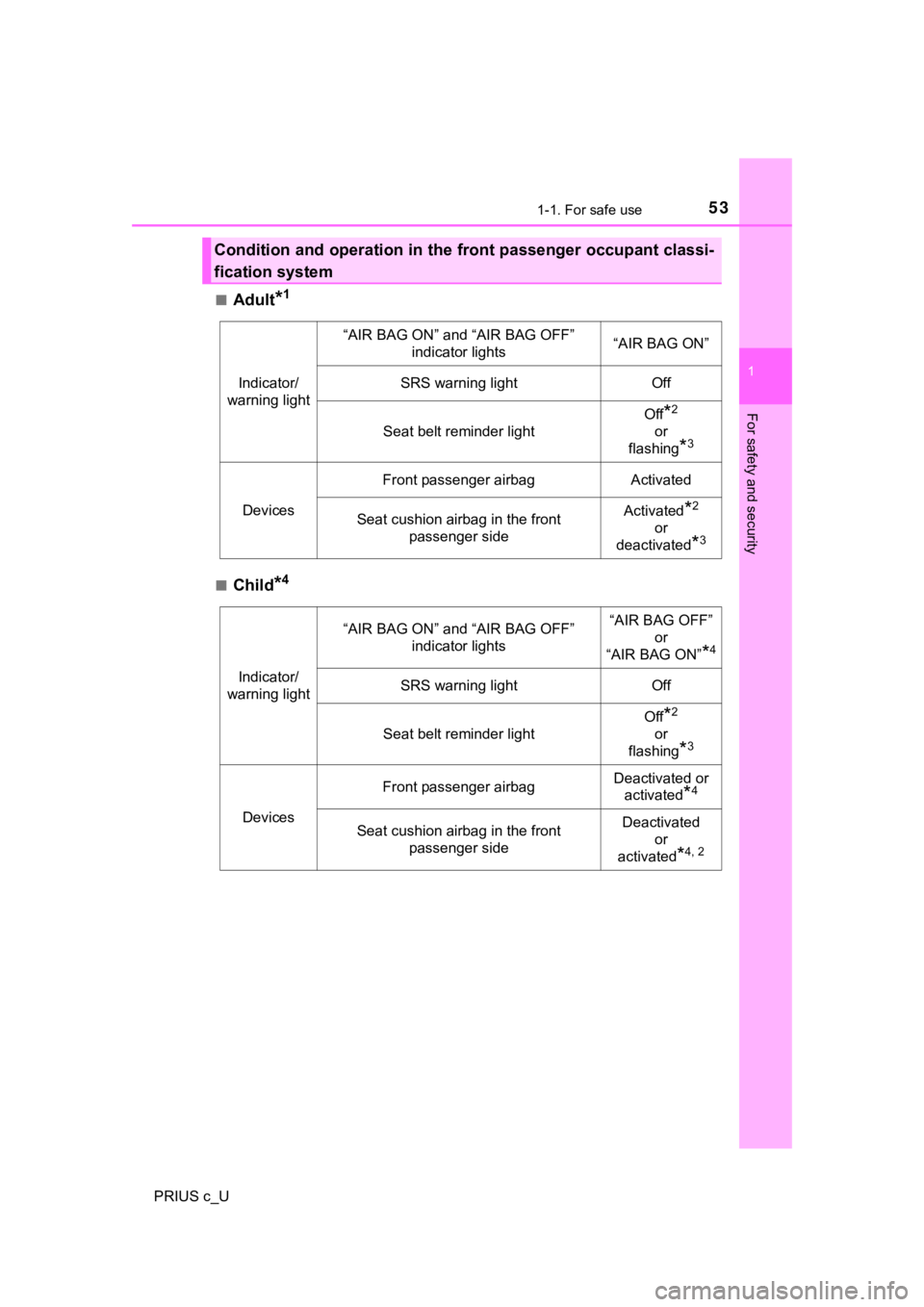ECU TOYOTA PRIUS C 2020 User Guide
[x] Cancel search | Manufacturer: TOYOTA, Model Year: 2020, Model line: PRIUS C, Model: TOYOTA PRIUS C 2020Pages: 600, PDF Size: 12.02 MB
Page 38 of 600

381-1. For safe use
PRIUS c_U
WARNING
■Using a seat belt extender
● Do not wear the seat belt extender if you can fasten the seat belt without
the extender.
● Do not use the seat belt extender when installing a child restr aint system
because the belt will not securely hold the child restraint system, increas-
ing the risk of death or serious injury in the event of an acci dent.
● The personalized extender may not be safe on another vehicle, when
used by another person, or at a different seating position othe r than the
one originally intended.
NOTICE
■ When using a seat belt extender
When releasing the seat belt, press on the buckle release butto n on the
extender, not on the seat belt.
This helps prevent damage to the vehicle interior and the extender itself.
Page 39 of 600

391-1. For safe use
1
For safety and security
PRIUS c_U
◆SRS front airbagsSRS driver airbag/front passenger airbag
Can help protect the head and c hest of the driver and front pas-
senger from impact with interior components.
SRS driver knee airbag
Can help provide driver protection.
SRS seat cushion airbags
Can help restrain the driv er and front passenger.
SRS airbags
The SRS airbags inflate when th e vehicle is subjected to certain
types of severe impacts that may cause significant injury to th e
occupants. They work together wit h the seat belts to help reduce
the risk of death or serious injury.
1
2
3
Page 41 of 600

411-1. For safe use
1
For safety and security
PRIUS c_U
SRS airbag system components
Curtain shield airbags
SRS warning light and “AIR
BAG ON” and “AIR BAG OFF”
indicator lights
Front side airbags
Side impact sensors (rear)
Front passenger’s seat cush-
ion airbag
Front passenger’s seat belt
buckle switch
Driver airbag
Driver’s seat belt buckle
switchDriver’s seat c
ushion airbag
Side impact sensors (front)
Seat belt pretensioners and
force limiters
Side impact sensors (front
door)
Driver’s knee airbag
Front passenger occupant
classification system (ECU
and sensors)
Airbag sensor assembly
Front impact sensors
Front passenger airbag1
2
3
4
5
6
7
8
9
10
11
12
13
14
15
16
17
Page 42 of 600

421-1. For safe use
PRIUS c_U
Your vehicle is equipped with ADVANCED AIRBAGS designed based
on the US motor vehicle safety standards (FMVSS208). The airbag
sensor assembly (ECU) controls airbag deployment based on infor-
mation obtained from the sensors etc. shown in the system compo -
nents diagram above. This informat ion includes crash severity and
occupant information. As the airbags deploy, a chemical reactio n in
the inflators quickly fills the airbags with non-toxic gas to h elp restrain
the motion of t he occupants.
WARNING
■SRS airbag precautions
Observe the following precautions regarding the SRS airbags.
Failure to do so may cause death or serious injury.
● The driver and all passengers in the vehicle must wear their se at belts
properly.
The SRS airbags are supplemental devices to be used with the se at belts.
● The SRS driver airbag deploys with considerable force, and can cause
death or serious injury especially if the driver is very close to the airbag.
The National Highway Traffic Safety Administration (NHTSA) advi ses:
Since the risk zone for the driver’s airbag is the first 2 - 3 in. (50 - 75 mm)
of inflation, placing yourself 10 in. (250 mm) from your driver airbag pro-
vides you with a clear margin of safety. This distance is measured from
the center of the steering wheel to your breastbone. If you sit less than 10
in. (250 mm) away now, you can change your driving position in several
ways:
• Move your seat to the rear as far as you can while still reach ing the ped-
als comfortably.
• Slightly recline the back of the seat. Although vehicle design s vary,
many drivers can achieve the 10 in. (250 mm) distance, even wit h the
driver seat all the way forward, simply by reclining the back o f the seat
somewhat. If reclining the back of your seat makes it hard to s ee the
road, raise yourself by using a firm, non-slippery cushion, or raise the
seat if your vehicle has that feature.
• If your steering wheel is adjustable, tilt it downward. This points the air-
bag toward your chest instead of your head and neck.
The seat should be adjusted as recommended by NHTSA above, whil e
still maintaining control of the foot pedals, steering wheel, and your view
of the instrument panel controls.
Page 43 of 600

431-1. For safe use
1
For safety and security
PRIUS c_U
WARNING
■SRS airbag precautions
● The SRS front passenger airbag also deploys with considerable f orce, and
can cause death or serious injury especially if the front passe nger is very
close to the airbag. The front passenger seat should be as far from the air-
bag as possible with the seatback adjusted, so the front passenger sits
upright.
● Improperly seated and/or restrained infants and children can be killed or
seriously injured by a deploying airbag. An infant or child who is too small
to use a seat belt should be properly secured using a child restraint sys-
tem. Toyota strongly recommends that all infants and children b e placed in
the rear seats of the vehicle and properly restrained. The rear seats are
safer for infants and children than the front passenger seat. ( P. 59)
●If the seat belt extender has been con-
nected to the front seat belt buckles but
the seat belt extender has not also been
fastened to the latch plate of the seat
belt, the SRS front airbags will judge
that the driver and front passenger are
wearing the seat belt even though the
seat belt has not been connected. In
this case, the SRS front airbags may
not activate correctly in a collision,
resulting in death or serious injury in the
event of a collision. Be sure to wear the
seat belt with the seat belt extender.
●Do not sit on the edge of the seat or
lean against the dashboard.
Page 45 of 600

451-1. For safe use
1
For safety and security
PRIUS c_U
WARNING
■SRS airbag precautions
● Do not hang coat hangers or other hard objects on the coat hook s. All of
these items could become projectiles and may cause death or ser ious
injury, should the SRS curtain shield airbags deploy.
● If a vinyl cover is put on the area where the SRS driver knee a irbag will
deploy, be sure to remove it.
● Do not use seat accessories which cover the parts where the SRS side
airbags and SRS seat cushion airbags inflate as they may interf ere with
inflation of the SRS airbags. Such accessories may prevent the side air-
bags and seat cushion airbags from activating correctly, disable the sys-
tem or cause the side airbags and seat cushion airbags to infla te
accidentally, resulting in death or serious injury.
● Do not strike or apply significant levels of force to the area of the SRS air-
bag components.
Doing so can cause the SRS airbags to malfunction.
● Do not touch any of the component parts immediately after the S RS air-
bags have deployed (inflated) as they may be hot.
● Do not attach anything to areas such as
a door, windshield glass, side door
glass, front or rear pillar, roof side rail
and assist grip.
● Vehicles without a smart key system:
Do not attach any heavy, sharp or hard
objects such as keys and accessories
to the key. The objects may restrict the
SRS driver knee airbag inflation or be
thrust into the driver’s seat area by the
force of the deploying airbag, thus caus-
ing a danger.
Page 47 of 600

471-1. For safe use
1
For safety and security
PRIUS c_U
■If the SRS airbags deploy (inflate)
●Slight abrasions, burns, bruising etc., may be sustained from S RS airbags,
due to the extremely high speed deployment (inflation) by hot g ases.
● A loud noise and white powder will be emitted.
● Parts of the airbag module (steering wheel hub, airbag cover an d inflator) as
well as the front seats, parts of the front and rear pillars, and roof side rails,
may be hot for several minutes. The airbag itself may also be h ot.
● The windshield may crack.
■ SRS airbag deployment condi tions (SRS front airbags)
● The SRS front airbags will deploy in the event of an impact tha t exceeds the
set threshold level (the level of force corresponding to an approximately 12 -
18 mph [20 - 30 km/h] frontal collision with a fixed wall that does not move or
deform).
However, this threshold velocity will be considerably higher in the following
situations:
• If the vehicle strikes an object, such as a parked vehicle or sign pole,
which can move or deform on impact
• If the vehicle is involved in an underride collision, such as a collision in
which the front of the vehicle “underrides”, or goes under, the bed of a
truck
● Depending on the type of collision, it is possible that only th e seat belt pre-
tensioners will activate.
● The SRS front airbags for the front passenger will not activate if there is no
passenger sitting in the front passenger seat. However, the SRS front air-
bags for the front passenger may deploy if luggage is put in the seat, even if
the seat is unoccupied.
● The SRS seat cushion airbag on the front passenger seat will not operate if
the occupant is not wearing a seat belt.
■ SRS airbag deployment conditions (SRS side and curtain shield a irbags)
● The SRS side and curtain shield airbags will deploy in the even t of an
impact that exceeds the set threshold level (the level of force corresponding
to the impact force produced by an approximately 3300 lb. [1500 kg] vehicle
colliding with the vehicle cabin from a direction perpendicular to the vehicle
orientation at an approximate speed of 12 - 18 mph [20 - 30 km/ h]).
● Both SRS curtain shield airbags will deploy in the event of veh icle rollover.
● Both SRS curtain shield airbags will deploy in the event of a s evere frontal
collision.
Page 49 of 600

491-1. For safe use
1
For safety and security
PRIUS c_U■
Types of collisions that may not deploy the SRS airbags (SRS si de and
curtain shield airbags)
The SRS side and curtain shield airbags may not activate if the vehicle is
subjected to a collision from the side at certain angles, or a collision to the
side of the vehicle body other than the passenger compartment.
The SRS side airbags do not generally inflate if the vehicle is involved in a
frontal or rear collision, if it rolls over, or if it is involv ed in a low-speed side
collision.
The SRS curtain shield airbags do not generally inflate if the vehicle is
involved in a rear collision, if it pitches end over end, or if it is involved in a
low-speed side or low-speed frontal collision. ● Collision from the side to the vehicle
body other than the passenger compart-
ment
● Collision from the side at an angle
●Collision from the front
● Collision from the rear
● Vehicle rollover
● Collision from the rear
● Pitching end over end
Page 51 of 600

511-1. For safe use
1
For safety and security
PRIUS c_U●
The portion of the front pillars, rear pil-
lars or roof side rail garnishes (padding)
containing the SRS curtain shield air-
bags inside is scratched, cracked, or
otherwise damaged.
Page 53 of 600

531-1. For safe use
1
For safety and security
PRIUS c_U■
Adult*1
■Child*4
Condition and operation in the front passenger occupant classi-
fication system
Indicator/
warning light
“AIR BAG ON” and “AIR BAG OFF” indicator lights“AIR BAG ON”
SRS warning lightOff
Seat belt reminder light
Off*2
or
flashing
*3
Devices
Front passenger airbagActivated
Seat cushion airbag in the front passenger sideActivated*2
or
deactivated
*3
Indicator/
warning light
“AIR BAG ON” and “AIR BAG OFF” indicator lights“AIR BAG OFF”
or
“AIR BAG ON”
*4
SRS warning lightOff
Seat belt reminder light
Off*2
or
flashing
*3
Devices
Front passenger airbagDeactivated or activated
*4
Seat cushion airbag in the front passenger sideDeactivated or
activated
*4, 2